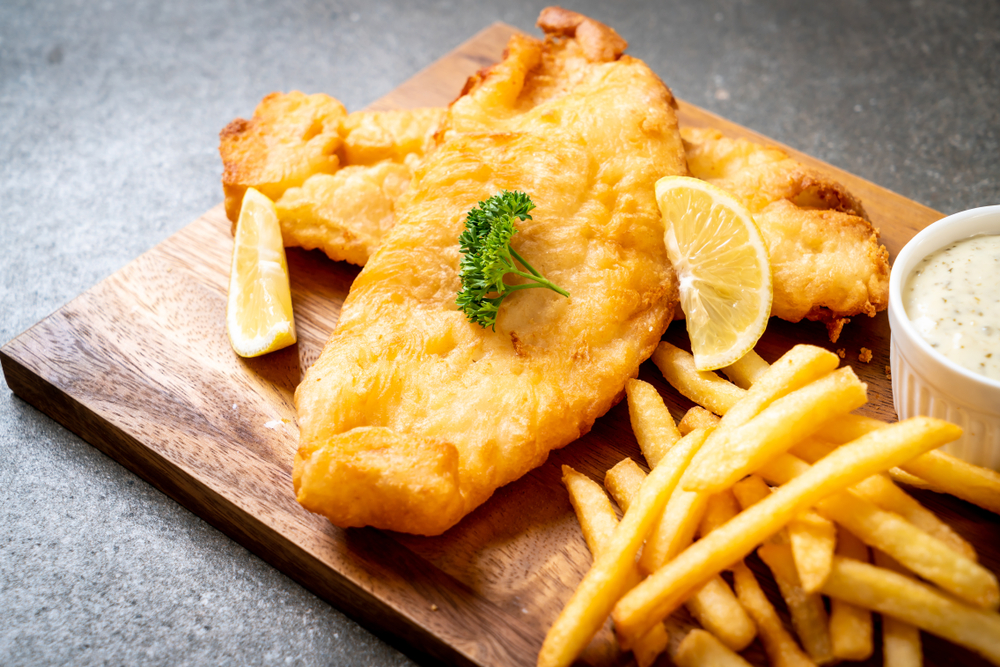Quenelles are a classic French dish that has been around for centuries. They are a mixture of creamed fish or meat, sometimes combined with breadcrumbs, with a light egg binding, formed into an egg-like shape, and then cooked.
The usual preparation is by poaching. Formerly, quenelles were often used as a garnish in haute cuisine. Today, quenelles are still popular and can be found in many fine dining restaurants around the world.
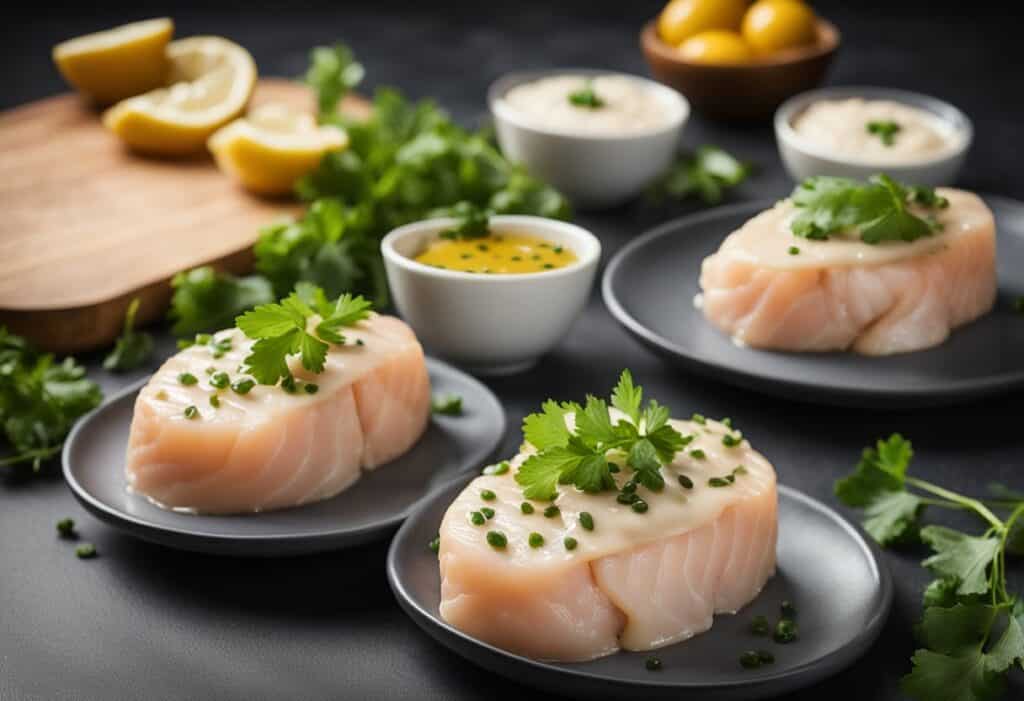
The art of making quenelles requires skill and patience. The mixture must be perfectly smooth and the shape must be consistent.
There are different types of quenelles, such as savory and sweet, and they can be served with various sauces. In addition, quenelles can be made with different ingredients, such as fish, meat, or vegetables.
They are also used in different cuisines, such as French, German, and Italian.
Key Takeaways
- Quenelles are a classic French dish made of creamed fish or meat, sometimes combined with breadcrumbs, with a light egg binding, formed into an egg-like shape, and then cooked.
- The art of making quenelles requires skill and patience, and there are different types of quenelles that can be served with various sauces.
- Quenelles can be made with different ingredients and are used in different cuisines around the world.
History and Origin of Quenelles
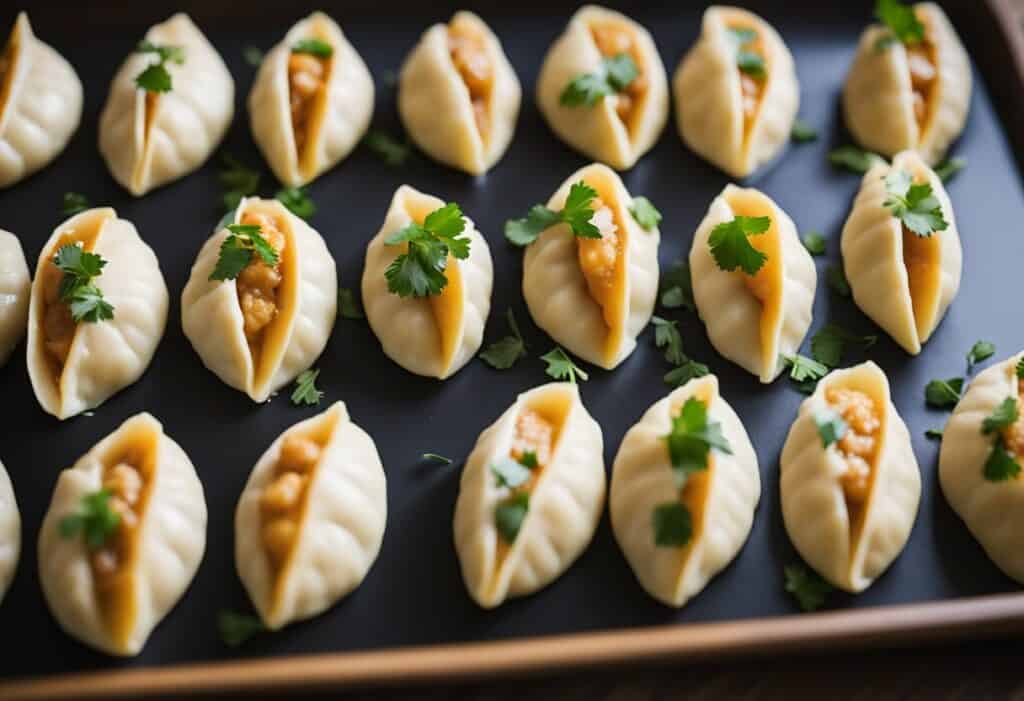 Quenelles are a traditional French dish that originated in Lyon, a city in southeastern France.
Quenelles are a traditional French dish that originated in Lyon, a city in southeastern France.
The dish was created in the 19th century by the renowned chef Antonin Carême, who is often referred to as the “king of chefs and chef of kings” [1].
Originally, quenelles were made with creamed fish, specifically pike, and were used as a garnish in haute cuisine [2].
However, today, quenelles are made with a variety of ingredients, including meat, poultry, fish, and vegetables, and are often served as a main dish or appetizer.
Quenelles are typically made by combining the main ingredient with breadcrumbs, eggs, fat, flour, or cream, and shaping the mixture into an oval shape.
The dumplings are then poached in water or stock until cooked through [3].
The dish has had a controversial history due to its association with anti-Semitic gestures and statements made by some individuals who have posed with the dish [2].
However, it remains a popular dish in French cuisine and can be found on the menus of many Michelin-starred restaurants.
In summary, quenelles are a traditional French dish that originated in Lyon in the 19th century. They were originally made with creamed fish and used as a garnish, but are now made with a variety of ingredients and served as a main dish or appetizer.
Despite a controversial history, quenelles remain a popular dish in French cuisine and can be found on the menus of many Michelin-starred restaurants.
[1] https://www.authentichospitalitygroup.com/quenelle/ [2] https://en.wikipedia.org/wiki/Quenelle [3] https://www.tasteatlas.com/quenelle
Types of Quenelles
Quenelles are a versatile food that can be made with a variety of ingredients. Here are some of the most popular types of quenelles:
- Fish Quenelles: Fish quenelles are a classic French dish that is made by combining creamed fish with breadcrumbs and eggs. They are often served with a creamy sauce and can be poached or baked.
- Meat Quenelles: Meat quenelles are similar to fish quenelles, but are made with meat instead of fish. They are often served with a rich sauce and can be poached or baked.
- Potato Quenelles: Potato quenelles are made by combining mashed potatoes with eggs and breadcrumbs. They are often served as a side dish and can be baked or fried.
- Ice Cream Quenelles: Ice cream quenelles are a popular dessert that is made by using a quenelle spoon to scoop ice cream into an oval shape. They are often served with a fruit sauce or chocolate drizzle.
- Sorbet Quenelles: Sorbet quenelles are similar to ice cream quenelles, but are made with sorbet instead of ice cream. They are often served as a refreshing dessert after a heavy meal.
- Mousse Quenelles: Mousse quenelles are made by using a quenelle spoon to scoop a mousse mixture into an oval shape. They are often served as a dessert and can be made with a variety of flavors.
- Pate Quenelles: Pate quenelles are made by combining a pate mixture with breadcrumbs and eggs. They are often served with crackers or bread as an appetizer.
- Caviar Quenelles: Caviar quenelles are a luxurious dish that is made by combining creamed fish with caviar and eggs. They are often served as an appetizer and can be poached or baked.
Overall, quenelles are a delicious and versatile food that can be made with a variety of ingredients.
Whether you are looking for a savory or sweet dish, there is a quenelle recipe out there that is sure to satisfy your taste buds.
The Art of Making Quenelles
Quenelles are a classic French culinary technique that can elevate the look and taste of any dish.
Making the perfect quenelle requires a bit of practice and finesse, but with the right tools and techniques, anyone can master this technique.
To create a quenelle, you’ll need a spoon or two spoons, depending on your preference. Traditionally, two spoons are used to shape a mound into the three-sided quenelle, but some chefs prefer to use just one spoon.
The spoon should be oval-shaped with pointed ends to create the classic quenelle shape.
The temperature and texture of the mixture used to create the quenelle are also crucial. The mixture should be well-seasoned and properly balanced in terms of flavors and textures.
It should have a light and airy texture, yet still be able to hold its shape. The mixture should be chilled before shaping to make it easier to work with.
To shape the quenelle, start by dipping the spoon(s) into cold water to prevent the mixture from sticking.
Then, use the spoon(s) to scoop up a portion of the mixture and shape it into an oval scoop. Use the movement of your wrist to create a smooth, uniform shape.
The quenelle should be slightly curved, with pointed ends.
The final step is to cook the quenelle. The usual preparation is by poaching, but it can also be baked or fried depending on the recipe.
With these tips and techniques, you can create the perfect quenelle to impress your guests and elevate your dishes to the next level.
Ingredients and Components
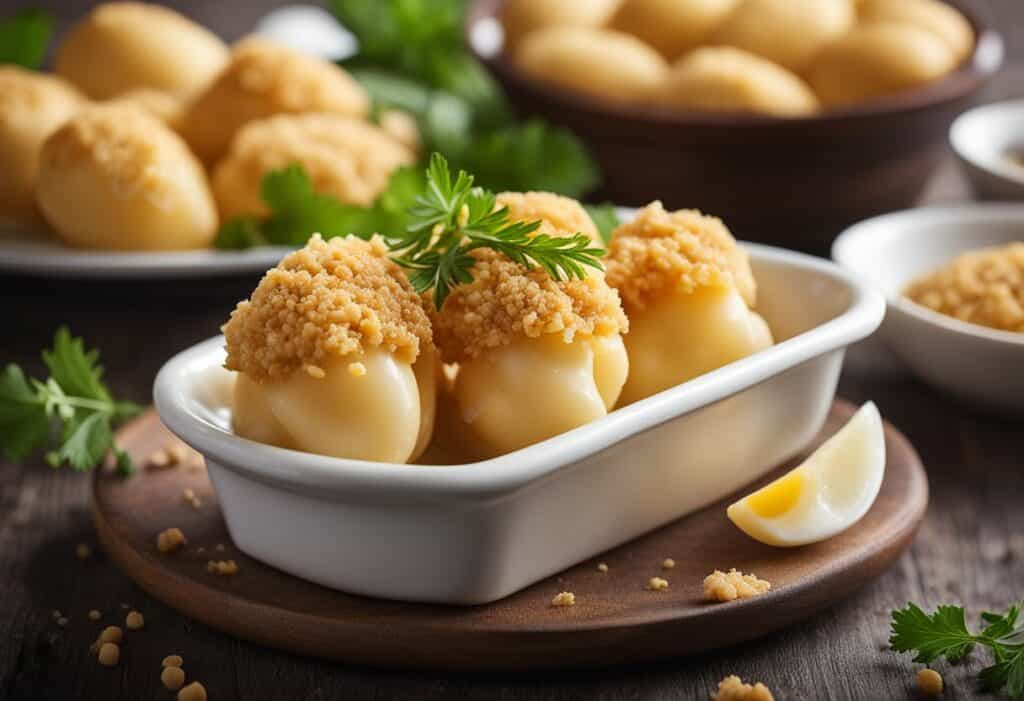
When it comes to making quenelles, the ingredients and components can vary depending on the recipe and the chef’s preferences.
However, there are some common ingredients and components that are often used in quenelle recipes.
One key component of quenelles is the egg binding. This is what helps hold the mixture together and gives it its unique shape.
Breadcrumbs are also often used to help bind the mixture together and add texture. Butter is another common ingredient that is added to give the quenelles a rich, creamy flavor.
In terms of the main ingredients, white fish is a popular choice for making quenelles. Pike and merlu hake fish are commonly used, but other types of white fish can also be used.
Veal is another ingredient that can be used to make quenelles, particularly in savory recipes.
Rice is sometimes used as a component in quenelles, particularly in Asian-inspired recipes. Panade, which is a mixture of bread and milk, is also sometimes used to help bind the quenelle mixture together.
Quenelles can also be made with meat, such as in meatball recipes. In these cases, the ingredients and components used will vary depending on the specific recipe.
Overall, the ingredients and components used in quenelles can vary depending on the recipe and the chef’s preferences.
However, egg binding, breadcrumbs, butter, white fish, veal, rice, and panade are all common ingredients and components that are often used in quenelle recipes.
Quenelles in Fine Dining
As a pastry chef in a fine-dining restaurant, I have seen how quenelles can elevate the presentation of a dish to a whole new level.
A quenelle is a football-shaped scoop of any soft food that can instantly upgrade the plating of a dish and give it a sophisticated touch.
In a 10-course degustation, quenelles can be used to add a touch of elegance to the dessert course. As an executive pastry chef, I have used quenelles to shape ice cream, sorbet, whipped cream, crème fraiche, and mousse into the classic three-sided shape.
This not only improves the look of the dish but also adds an element of texture and depth.
Quenelles are not just limited to desserts, they can also be used in savory dishes. Chefs often use quenelles to shape purees, mousses, and other soft foods to create a visually appealing plate.
Quenelles can be used to add an edge to the plating of a dish and make it stand out.
In a fine-dining restaurant, the presentation of a dish is just as important as the taste. Quenelles are a simple yet effective way to add a touch of sophistication to a dish and make it look more appealing to the eye.
As a pastry chef, I have found that mastering the art of making quenelles is an essential skill to have in my repertoire.
Quenelles with Various Sauces
Quenelles are a traditional French dish made from pike or other white fish, shaped into small oval dumplings and served in various sauces.
The sauces used in quenelles vary depending on the region and personal preference. Some of the most popular sauces used in quenelles include sauce Nantua, crayfish sauce, and crème fraîche.
Sauce Nantua is a creamy sauce made from crayfish butter, heavy cream, and tomato paste. This sauce is a popular accompaniment to quenelles and adds a rich and savory flavor to the dish.
The crayfish butter used in the sauce is made by blending crayfish shells with butter, which gives the sauce a distinct and delicious taste.
Crayfish sauce is another popular sauce used in quenelles. This sauce is made by sautéing shallots and garlic in butter, adding white wine and reducing it, and then adding crayfish tails and heavy cream.
The sauce is then pureed and strained to create a smooth and creamy texture. The sauce has a rich and slightly sweet flavor that pairs well with the delicate flavor of the quenelles.
Crème fraîche is a tangy and creamy sauce that is often used as a topping for quenelles. This sauce is made by fermenting heavy cream with a bacterial culture, which gives it a slightly sour taste.
The sauce is then thickened with gelatin or cornstarch to create a creamy texture. Crème fraîche is a versatile sauce that can be used in a variety of dishes, including quenelles.
Overall, quenelles are a delicious and versatile dish that can be served with a variety of sauces.
Whether you prefer a rich and creamy sauce like sauce Nantua or a tangy and refreshing sauce like crème fraîche, there is a quenelle sauce that will suit your taste.
Quenelles in Different Cuisines
As mentioned earlier, quenelles originated from French cuisine, specifically from the dish called quenelles de brochet.
However, over time, quenelles have evolved and are now used in various cuisines worldwide.
In French cuisine, quenelles are still a popular dish, often served as an appetizer or main course. They are commonly made with fish, chicken, or veal, and served with a creamy sauce.
Quenelles are also a common ingredient in the French dish, vol-au-vent, which is a puff pastry filled with various ingredients, including quenelles.
In Mediterranean cuisine, quenelles are often served as an appetizer with baguette and tapenade. The quenelles are typically made with fish or vegetables and are served with a flavorful dip like tapenade.
In Italian cuisine, quenelles are called gnocchi and are made with potato, flour, and eggs. They are often served with a tomato-based sauce and cheese.
In Indian cuisine, quenelles are known as kofta and are made with minced meat or vegetables, mixed with spices and shaped into balls. They are often served in a rich gravy and accompanied by rice or bread.
Overall, quenelles have become a versatile dish, used in various cuisines worldwide. Their unique shape and texture make them a popular choice for appetizers, main courses, and even desserts.
Quenelles and Garnishing Techniques
Quenelles are a classic French culinary technique where a soft food is shaped into an oval or football shape.
The technique is often used for dishes like pâté, sorbet, or mousse. To make a quenelle, you will need an oval-shaped spoon and a glass of hot water.
Once you have the spoon ready, dip it into the hot water to warm it up. Then, use the spoon to scoop out the soft food and shape it into an oval or football shape.
This technique takes some practice to master, but it can add an elegant touch to any dish.
After shaping the quenelle, you have the option to garnish it with various ingredients. Chefs often use a light dusting of flour or breadcrumbs to give the quenelle a crispy exterior when cooked.
You can also use whipped cream or a smooth paté to add flavor and texture to the dish.
When garnishing a quenelle, it’s important to consider the overall presentation of the dish. A well-garnished quenelle can elevate the dish and make it more visually appealing.
Some garnishing techniques include using fresh herbs, edible flowers, or colorful sauces.
In summary, quenelles are a classic French culinary technique used to shape soft foods into an oval or football shape.
Garnishing techniques like a light dusting of flour or breadcrumbs, whipped cream, or smooth paté can add flavor and texture to the dish.
When garnishing a quenelle, it’s important to consider the overall presentation of the dish.
Using Molds for Quenelles
I find that using molds for quenelles is a great way to achieve consistent and professional-looking results. Silicone molds are particularly useful because they are flexible, non-stick, and easy to use.
To use a silicone mold for quenelles, first, make sure the mold is clean and dry. Then, fill the mold with your desired mixture, such as ice cream or mousse.
Use a small spatula or spoon to smooth the surface of the mixture, making sure it fills the mold evenly.
Next, use a flat edge, such as a bench scraper or the back of a knife, to scrape off any excess mixture from the top of the mold. This will ensure that your quenelles have a smooth and even surface.
Once the mold is filled and smoothed, place it in the freezer for at least a few hours, or until the mixture is completely frozen.
When you’re ready to serve your quenelles, simply remove the mold from the freezer, gently push on the bottom of the mold to release the quenelles, and place them on your serving dish.
Using molds for quenelles is not only a great way to achieve consistent results, but it’s also a time-saver.
You can make a large batch of quenelles in advance and store them in the freezer until you’re ready to serve them.
Overall, I highly recommend using silicone molds for quenelles. They’re easy to use, produce consistent results, and are a great tool to have in your kitchen.
Quenelles in Singapore

As a foodie destination, Singapore offers a diverse range of culinary experiences, including the traditional French dish of quenelles.
Quenelles are typically made by combining creamed fish with breadcrumbs and egg binding, forming them into an egg-like shape, and then poaching them.
One place to try quenelles in Singapore is at the Hilton Singapore’s restaurant, Opus Bar & Grill. The restaurant serves up a delicious quenelle dish made with salmon, which is poached and served with a creamy leek sauce.
Another option is the Shangri-La Hotel Singapore’s restaurant, The Line. The restaurant offers a culinary journey through different cuisines, and their quenelles are made with prawns and served with a lobster bisque.
Cindy Khoo, a food magazine writer and communications professional, recommends trying the quenelles at the Michelin-starred French restaurant, Les Amis.
The restaurant’s quenelles are made with pike and served with a lobster sauce.
Rachel Tan, a journalist and food critic, suggests trying the quenelles at the French restaurant, Odette. The restaurant’s quenelles are made with crayfish and served with a rich bisque sauce.
Overall, there are many great options to try quenelles in Singapore, and it’s a dish that is sure to impress any foodie.
Storing and Serving Quenelles
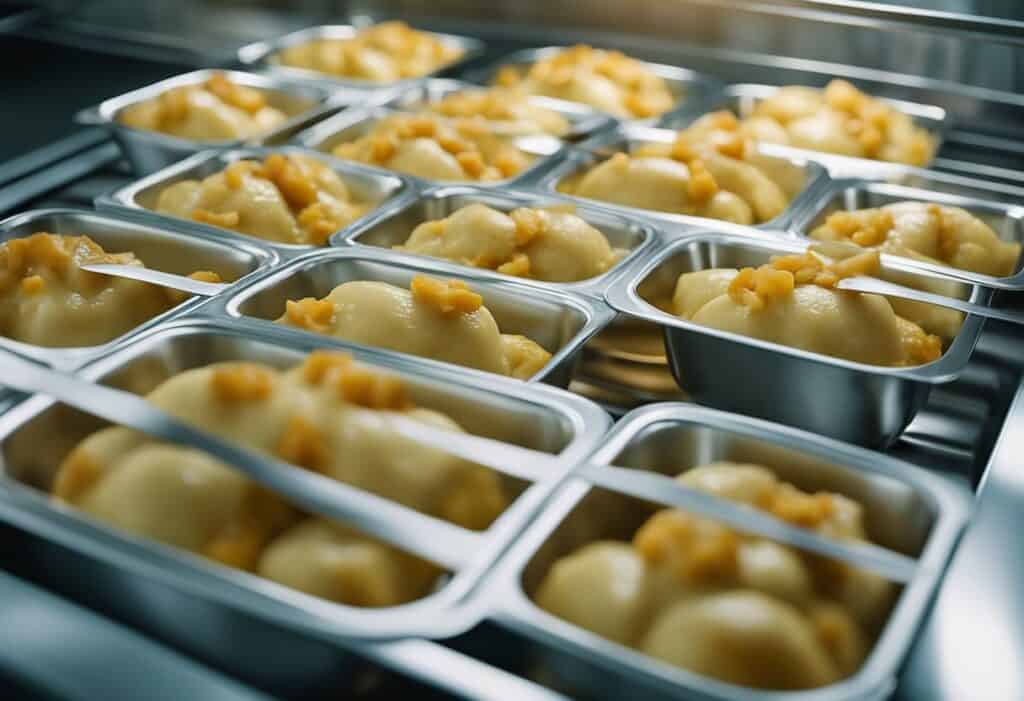
When it comes to storing quenelles, it’s best to keep them in a covered container in the refrigerator. They should be consumed within a day or two of being made.
If you want to store quenelles for longer, you can freeze them for up to a month. To freeze quenelles, place them on a baking sheet and put them in the freezer for a few hours until they are solid.
Then transfer them to a freezer-safe container or bag.
When you’re ready to serve quenelles, you can reheat them by either poaching them in hot water or warming them in the oven.
To poach quenelles, bring a pot of water to a simmer and gently drop in the quenelles. Cook them for a few minutes until they are heated through.
To warm quenelles in the oven, preheat the oven to 350°F (175°C) and place the quenelles on a baking sheet. Bake them for 10-15 minutes until they are heated through.
It’s important to note that quenelles are delicate and can easily fall apart if mishandled. When serving quenelles, use a slotted spoon to transfer them from the poaching liquid to the plate.
This will help prevent them from breaking apart. You can serve quenelles with a variety of sauces, such as cream sauce, tomato sauce, or beurre blanc.
Overall, quenelles are a delicious and elegant dish that can be enjoyed on their own or as a side dish. By following these tips for storing and serving quenelles, you can ensure that they are always fresh and flavorful.
Quenelle Recipes
As a trained commis, I have learned how to prepare quenelles in various ways. From classic recipes to modern twists, quenelles can be made with a variety of ingredients and sauces.
One traditional recipe is Quenelles Nantua, which features light and fluffy fish dumplings in a creamy shellfish sauce.
This dish is a highlight of French regional cooking and is often served as a main course. A recipe for Quenelles Nantua can be found on the Los Angeles Times website.
Another classic recipe is the textbook quenelle, which is typically made with a mixture of fish, eggs, and cream.
The mixture is then shaped into an oval shape and poached in a flavorful broth. A recipe for the textbook quenelle can be found on Pastry Chef Online.
For those who prefer a modern twist, there are plenty of unique quenelle recipes available online.
One such recipe is Lyonnaise Quenelles in Cream Sauce, which features quenelles covered in a rich and flavorful cream sauce. A recipe for Lyonnaise Quenelles can be found on Snippets of Paris.
If you are a visual learner, there are also many video tutorials available online that demonstrate how to make quenelles.
These tutorials can be helpful for those who are new to the technique or who want to learn new recipes.
Overall, quenelles are a versatile dish that can be made in a variety of ways. Whether you are a traditionalist or a modernist, there is a quenelle recipe out there for you.
Frequently Asked Questions
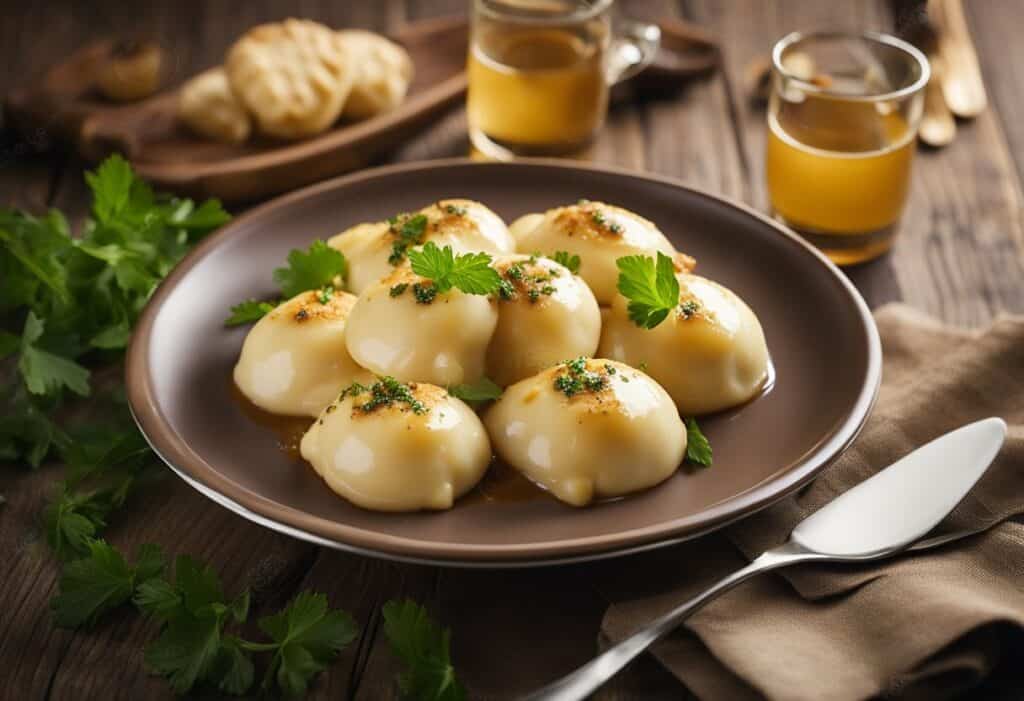
What is a quenelle de brochet?
A quenelle de brochet is a traditional French dish that consists of a mixture of creamed fish combined with breadcrumbs and an egg binding, formed into an egg-like shape and poached.
The dish is typically made with pike fish and is commonly served with a creamy sauce. However, nowadays, the term “quenelle” is used much more loosely and refers to dumplings made from all ingredients.
How do you make quenelles?
To make quenelles, you typically start by making a paste or dough with ingredients such as flour, eggs, butter, and milk.
The paste is then shaped into an oval shape using two spoons or a special quenelle spoon. The quenelles are then poached in a liquid, such as broth or cream, until cooked through.
Quenelles can be made with a variety of ingredients, including fish, meat, vegetables, and even ice cream.
What do quenelles taste like?
The taste of quenelles varies depending on the ingredients used. For example, quenelles made with fish have a delicate and slightly sweet flavor, while those made with meat have a richer, more savory taste.
Quenelles made with sweet ingredients, such as ice cream, have a sweet and creamy flavor.
What is the purpose of a quenelle?
The purpose of a quenelle is to add an elegant and sophisticated touch to a dish.
Quenelles are typically used as a garnish or side dish and can be served with a variety of dishes, such as meat, fish, and vegetables. They can also be used as a base for sauces or as a filling for other dishes.
What is a quenelle dessert?
A quenelle dessert is a sweet version of a quenelle that is typically made with ingredients such as whipped cream, ice cream, or mousse.
Quenelle desserts are often served as a standalone dessert or as a garnish for other desserts, such as cakes or pies.
What is the shape of a quenelle?
The shape of a quenelle is typically oval or egg-shaped, with slightly pointed ends.
The shape is achieved by using two spoons or a special quenelle spoon to shape the paste or dough into an oval shape before poaching.





